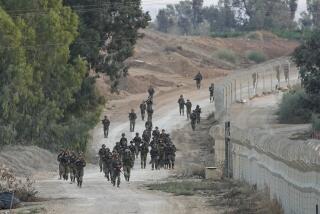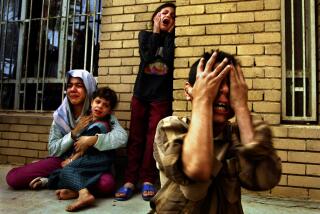Army Takes Its War Effort to Task
- Share via
FT. LEAVENWORTH, Kan. — American soldiers who defeated the Iraqi regime 15 months ago received virtually none of the critical spare parts they needed to keep their tanks and Bradley fighting vehicles running. They ran chronically short of food, water and ammunition. Their radios often failed them. Their medics had to forage for medical supplies, artillery gunners had to cannibalize parts from captured Iraqi guns and intelligence units provided little useful information about the enemy.
These revelations come not from embedded reporters or congressional committees but from the Army itself. In the first internal assessment of the war in Iraq, an exhaustive Army study has concluded that American forces prevailed despite supply and logistical failures, poor intelligence, communication breakdowns and futile attempts at psychological warfare.
The 542-page study, declassified last month, praises commanders and soldiers for displaying resourcefulness and resiliency under trying conditions, and for taking advantage of superior firepower, training and technology.
But the report also describes a broken supply system that left crucial spare parts and lubricants on warehouse shelves in Kuwait while tankers outside Baghdad ripped parts from broken-down tanks and raided Iraqi supplies of oil and lubricants.
“No one had anything good to say about parts delivery, from the privates at the front to the generals” at the U.S. command center in Kuwait, the study’s authors concluded after conducting 2,300 interviews and studying 119,000 documents.
Among other highlights, the report revealed that the toppling of the Saddam Hussein statue in Baghdad before cheering Iraqis was the brainchild of a U.S. Marine colonel, with help from a psychological operations unit. The report also credited a U.S. Army colonel with shortening the war by “weeks, if not months” with his dramatic “thunder run” into Baghdad.
Portions of an early draft of the report were described by the New York Times in an article in February. The study has since been revised and refined, but the overall conclusions in the final, unclassified report have not changed significantly.
Within the Third Infantry Division (Mechanized), which spearheaded the U.S. assault on Baghdad, “literally every maneuver battalion commander asserted that he could not have continued offensive operations for another two weeks without some spare parts,” the study said.
The study, titled “On Point” and aimed at “lessons learned,” is at odds with the public perception of a technologically superior invasion force that easily drove Hussein from power. In fact, as the authors point out in their battle-by-battle narrative, there were many precarious moments when U.S. units were critically short of fuel and ammunition, with little understanding of the forces arrayed against them.
The report, by the Operation Iraqi Freedom Study Group at Ft. Leavenworth, called ammunition resupply “problematic” and said the medical supply system “failed to work.” Engineers desperate for explosives foraged for Iraqi explosives and tore apart mine-clearing charges to use the explosives to blow up captured Iraqi equipment.
Many soldiers plunged into combat not knowing whether they had enough food or water to sustain themselves in punishing heat and blinding sandstorms. “Stocks of food barely met demand,” the study said. “There were times when the supply system was incapable of providing sufficient MREs for the soldiers fighting Iraqi forces.”
Military intelligence provided little useful information about the deployment or intentions of Iraqi forces, the study concluded. A Third Infantry tank commander whose company was attacked by Iraqi fighters hidden in an elaborate bunker and trench system in Baghdad on April 8 told The Times that he later learned from a French journalist that newspapers had reported details of the bunker network. Yet his own intelligence officers had told him nothing.
Most significantly, military planners did not anticipate the effectiveness or ferocity of paramilitary forces that disrupted supply columns and mounted suicide charges against 70-ton Abrams tanks. Some of those same forces, using tactics refined during the invasion, are part of the current insurgency.
The study, which covers events in Kuwait and Iraq until President Bush declared major combat operations over on May 1, 2003, does not address the insurgency, which has killed far more Americans than were killed during the so-called combat phase. Nor does the study discuss the Pentagon’s failure to anticipate or control the looting and chaos following the collapse of the Iraqi regime in April 2003.
But the report does say that the military’s “running start” -- the strategy of launching the invasion before all support units had arrived -- made it difficult for commanders to quickly adjust from major combat to postwar challenges. Because combat units outraced supply and support units, combat commanders were caught unprepared when Hussein’s regime collapsed after three weeks.
“Local commanders were torn between their fights and providing resources -- soldiers, time and logistics -- to meet the civilian needs,” the report said. “Partially due to the scarce resources as a result of the running start, there simply was not enough to do both missions.”
The report does not address the Bush administration’s stated reasons for the invasion -- Iraq’s alleged weapons of mass destruction, purported operational links between Baghdad and Al Qaeda, and atrocities committed under Hussein’s dictatorship. Instead, the study critiques the Army’s combat performance with an eye toward future wars.
The principal authors -- retired Col. Gregory Fontenot, Lt. Col. E.J. Degen and Lt. Col. David Tohn -- warned that Iraqi forces could have created significant problems if they had attacked relatively undefended U.S. units staging in Kuwait in the winter of 2002-03. Those units arrived without significant firepower or reinforcements and were vulnerable to a surprise attack.
The authors also said Iraqis could have extended the battle for Baghdad for weeks if they had destroyed or blocked approaches to the capital, or had forced American troops to fight a drawn-out battle in dense urban areas. (Former Republican Guard commanders interviewed by The Times in Baghdad said Hussein left the highways to Baghdad open because he thought his own forces would need them once they blocked the American invasion south of the capital.)
In an interview Friday, Fontenot said the Army excelled at “joint operations,” integrating infantry, armor, artillery and air power to great effect during the war. “Arguably, the integration of joint warfare reached a level we had not seen at least since the Korean War,” he said.
He also praised the effective use of Special Forces, the successful “pre-positioning” of vast quantities of materiel in the Middle East, and the quality of Army training. Fontenot, a tank battalion commander during the first Gulf War, said officers and men at the tactical level were better prepared last year than 13 years ago.
“I thought I was a pretty good tank commander, but the quality of these battalions is far better than we were,” he said. “I was really impressed by the quality of the tactical leadership.”
Fontenot said the narrative study, ordered by former Army Chief of Staff Gen. Eric K. Shinseki, was not intended as the “seminal work” on the war. Rather, he said, “it’s a first look.”
The study credits a relatively junior commander -- Col. David Perkins of the Second Brigade of the Third Infantry Division -- with shortening the war with a bold armored strike into the heart of Baghdad on April 7. Perkins’ “thunder run” surprised Baghdad’s defenders with its speed and firepower, collapsing the regime from within before Iraqi forces could draw the Americans into a protracted urban war.
The authors said Perkins “made the single decision that arguably shortened the siege by weeks, if not months.”
The Pentagon’s plan for Baghdad had envisioned a series of attacks to slowly chip away at the regime. But the authors said Perkins’ decision to suddenly revise the plan under fire and stay in downtown Baghdad was a prime example of flexibility and innovation by both the Pentagon brass and commanders in the field.
They “rapidly adapted and fought the enemy they found rather than the one they planned on,” the study said.
U.S. forces prevailed despite seriously underestimating paramilitary forces, especially Saddam Fedayeen, Baath Party militiamen, al Quds local militiamen and Muslim jihadists from Syria, Jordan and other Middle Eastern countries, the study said. Those fighters harassed U.S. supply columns and nearly overran Col. Perkins’ forces along Highway 8 south of Baghdad on April 7.
“The intelligence and operations communities had never anticipated how ferocious, tenacious and fanatical they would be,” the authors said. By dressing in civilian clothes and firing from civilian neighborhoods, paramilitaries were able to “hide with some success from the incredible array of technical intelligence” available to U.S. forces.
Efforts by psychological operations units to persuade Iraqi forces to surrender largely failed, the study concluded.
Despite success in minimizing damage to oil fields, the psychological units “produced much less than expected and perhaps less than claimed,” the authors said. Some leaflets baffled Iraqi forces, while others were outdated, forcing units to resort to loudspeaker broadcasts, the report said.
Poor U.S. intelligence efforts were compounded by ground commanders’ decisions -- because of the dangers involved -- not to send scouts and other reconnaissance troops ahead to report on enemy positions.
In addition, long-range surveillance units flying in lightly equipped helicopters “did not produce great effect for the investment of talent and the risk to those involved,” the report said.
More to Read
Sign up for Essential California
The most important California stories and recommendations in your inbox every morning.
You may occasionally receive promotional content from the Los Angeles Times.











